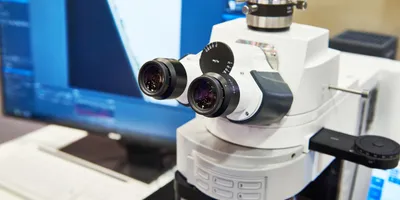Microscopy remains a core technique in research and quality assurance. However, its analytical utility can be limited without complementary data, whether its chemical, thermal, or mechanical. In traditional workflows, that may require multiple technicians, switching between instruments, and manually integrating results from separate systems. Conversely, integrated microscopy workflows combine multiple analytical systems to reduce analysis time, minimize rework, and enable context-rich data interpretation under time-sensitive conditions.
Expanding analytical capability through multimodal integration
Integrating microscopy with other analytical methods enables labs to generate more complete, directly correlated datasets. Several broad analytical categories lend themselves especially well to integration with microscopy and are increasingly central to efficient lab workflows:
Spectroscopy
Use: Adds molecular or chemical functional group information to visual observations.
Example: Identifying mixed polymer domains in a blend using optical microscopy alongside infrared spectroscopy.
Benefit: Improves material verification via correlation of visual structure with chemical composition.
Thermal analysis
Use: Links physical changes driven by heat absorption to visible structural effects.
Example: Monitoring heat-induced transitions in emulsions while observing structural breakdown under polarized light.
Benefit: Connects visible microscopic changes with thermal behavior, which is important for stability studies.
Mechanical failure testing
Use: Shows how mechanical stress relates to failure at the microscopic level.
Example: Imaging fracture surfaces of a composite after tensile testing.
Benefit: Links physical failure with visible deformation patterns to guide design improvements.
Electrical or conductivity measurements
Use: Combines imaging with electronic performance data.
Example: Examining surface defects on a printed circuit while monitoring for local electrical resistance.
Benefit: Combines structural and functional data for troubleshooting.
Elemental mapping
Use: Pinpoints what and where specific elements or compounds are present.
Example: Combines scanning electron microscopy (SEM) with energy-dispersive X-ray (EDX) analysis to investigate contamination in a metal part.
Benefit: Enables spatially resolved chemical identification for quality investigations.
Implementing multimodal microscopy workflows in the lab
Lab managers considering integrated microscopy workflows need to select the right combination of techniques to achieve a balance of performance, practicality, and purpose. When thoughtfully integrated, multimodal microscopy systems can increase confidence in results and reduce time spent on multiple instruments or re-running analyses.
Successful implementation depends on practical planning involving these main areas:
Integration
Look for hyphenated systems with integrated microscopy and analysis functions built into a single instrument, like SEM-EDX, microscope FTIR, or advanced AFM platforms
Lab Management Certificate
The Lab Management certificate is more than training—it’s a professional advantage.
Gain critical skills and IACET-approved CEUs that make a measurable difference.
Compatibility and workflow fit
Investigate microscopy workflows for samples and projects that require both microscopy and other characterization. Prioritize systems that align with the lab’s sample types and throughput demands.
Data integration and interpretation
Seek software applications that can handle and harmonize data from multiple sources, including spatial, spectral, and physical formats.
Regulatory and documentation requirements
Ensure integrated workflows meet relevant standards for traceability, validation, and audit readiness, especially in regulated environments.
Scalability and flexibility
Prioritize platforms and protocols that are flexible for expansion or reconfiguration.
Reproducibility and documentation
Ensure that the combined techniques meet or exceed all required standard operating procedures and validation protocols.
Toward more connected analytical workflows
As microscopy becomes more interconnected with complementary techniques, labs are setting new standards for streamlined data collection. With ongoing improvements in software, automation, and instrument compatibility, multimodal analysis is becoming increasingly practical for labs looking to modernize and streamline their analytical capabilities. When well-implemented, these systems can improve turnaround time while enhancing the consistency and interpretability of complex datasets.











